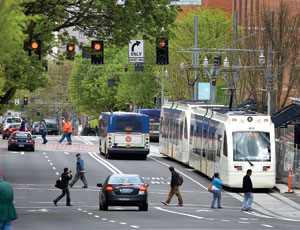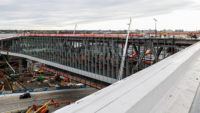The U.S. Dept. of Transportation is changing the criteria it uses to evaluate which new transit projects it will fund. Industry officials say the shift is likely to give a boost to streetcar and urban light-rail projects in the competition for federal money, but other options, such as bus rapid transit, will still be in the game.

In unveiling the shift on Jan. 13, DOT Secretary Ray LaHood said the Federal Transit Administration now will consider a project’s environmental and economic-development benefits along with congestion-relieving features. LaHood said, “We want to base our decisions on how much transit helps the environment, how much it improves development opportunities, and how it makes our communities better places to live.”
LaHood, who has been emphasizing transportation’s role in making communities more “livable,” said that DOT immediately has rescinded a 2005 Bush administration policy of recommending federal funding for only new transit projects that had a rating of “medium” or better for a single category -- “cost-effectiveness,” as measured by projected savings in travel time and related cost.
Instead, DOT will follow the much broader set of criteria spelled out in the 2005 Safe, Accountable, Flexible, Efficient Transportation Equity Act: a Legacy for Users for projects that receive capital funding. Those factors include environmental benefits and economic development. It also will continue to include cost-effectiveness, but not as the only yardstick.
LaHood said new projects now must achieve an overall rating of “medium” or higher, after all factors are weighed, to be recommended for funding. Thus, a plan would have to get at least a medium rating for local financial commitment and project justification.
Streetcars are expected to be an immediate beneficiary of the new standard. Under the Bush directive, it was extremely difficult for streetcar plans to achieve a medium rating on cost-effectiveness.
Urban light-rail and streetcar plans have been at a disadvantage in seeking federal aid because they included stations that were located close together, had relatively slow train speeds and had riders who tended not to live far away from the transit lines. Thus, such proposals did not show large projected gains in travel times, compared with rail plans whose stations were more widely spaced.
Observers agree, however, that the changes won’t put non-streetcar projects out of the running for federal aid. “There aren’t any losers in this policy shift,” says Liz Rao, national public-transit services chairwoman for HNTB. If the number of new-starts applicants climbs, “We’re hoping that more money gets advanced in the new [highway-transit] authorization, she adds. FTA’s fiscal year 2010 appropriation for capital grants is $2 billion. In 2009, it was $2.6 billion, including $750 million from the American Recovery and Reinvestment Act.
Jeffrey Boothe, chairman of the New Starts Working Group, which includes transit agencies and cities, says, “I think [the new policy’s] greater impact is going to be shaping alignment choices and alignment decisions.” Boothe, who also is executive director of the Community Streetcar Coalition, says that, under the new standards, a route planned to be located in a freight railroad right-of-way or Interstate median may not be as attractive as an alignment around which greater development benefits can be created through land-use decisions and other actions.
LaHood’s move to cancel the 2005 directive is just the first step for DOT in carrying out the new approach. FTA says changes in its overall new-starts project evaluation system won’t occur until a revised regulation is made final. The agency says it will propose a new rule for public comment soon.



Post a comment to this article
Report Abusive Comment